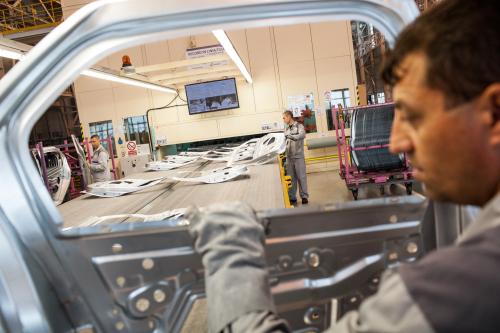The second in a two-piece series, this blog explores underlying causes of Romania’s skills deficit and proposes strategies to tackle them.
Given the rapid pace of transformation and disruption of global economies driven by technological development, Romania needs to invest in the right skills and training models to keep pace with the rapid change in technology and markets. Countries at the economic frontier are forward-looking, have robust economies, are open to investment and technology, and have competitive, well-matched workforces. In a previous blog, we explored the extent of this skills deficit.
The COVID-19 pandemic has made investing in the right skills more urgent. The lockdown has left thousands of workers unemployed and forced schools and universities to close, increasing the urgency of strategies for massive upskilling and retraining that is properly aligned with evolving labor market needs. A flexible workforce system that embraces technology and incentivizes employers’ participation will be more important than ever.
Why are adequate skills relevant to the economy?
Skills and knowledge, key components of human capital, are fundamental for long-term economic growth. They enable people to realize their potential as productive members of society, while it has become increasingly important to keep accumulating them throughout one’s life. Romania’s growth statistics over the last two decades show that the contribution of human capital to economic growth has been marginal compared to that of its physical capital stock and is declining. It decreased from an annual average of 4 percent between 1999 and 2008 to only 1 percent between 2009 and 2018. Meanwhile, the contribution of physical capital stock has remained near 40 percent. The recent Romania CEM2.0 Report found that improvements within individual firms have contributed little or negatively to aggregate productivity growth, suggesting that there is scope to improve firms’ capabilities, including managerial capabilities and employees’ skills. Skills deficits and accompanying skills mismatches, both of which are present in Romania, lead to potential loss of productivity, particularly when employers are forced to place lower-skilled workers in skilled positions, and have a negative impact on economic growth.
What are the underlying causes of Romania’s skills deficit?
Several factors contribute to Romania’s skills deficit, including institutional shortcomings in the education system, emigration patterns, and low participation in lifelong learning, particularly within firms, all of which have led to insufficient numbers of highly skilled workers (see Figure 1) to sustain the pace of growth.
Assessment of the Romanian education system suggests that current teaching approaches do not develop complex, higher-order skills (see the OECD 2017 Reviews of Evaluation and Assessment in Education). Romanian employers are critical of the relevance of the education system for several reasons. According to a 2017 World Bank Group survey, the curriculum for both secondary and tertiary education was reported to be overly theoretical, with a focus on abstract concepts rather than practical applications. Employers described teaching methods as outdated and highly traditional, with a focus on memorization rather than application. They also characterized the education system, at both pre-university and university levels, as highly resistant to change. Another shortcoming is underfinancing. At only 2.8 percent of GDP in 2017, Romania’s spending on education is the lowest in the European Union, with less than 2 percent of GDP for pre-tertiary education, which is less than half the EU-28 average.
Emigration of highly skilled workers aggravates the skills deficit. In the first decade of the 2000s, Romania recorded the largest increase of high-skilled immigration into the G-20 countries (reaching about 492,000 persons in 2010–11). The share of highly educated people amongst all emigrants was also high, at 23 percent as of 2010, the latest year for which data are available (World Bank 2018: Romania Systematic Country Diagnostic).
Adult participation in lifelong learning, at 1.1 percent in 2017, is the lowest in the EU, reflecting a disconnect between employers, workers, and education and training providers but also a limited provision of Continued Vocational Training (CVT). Most enterprises (73 percent) in Romania do not provide CVT, which is the traditional way by which employers respond to skills shortages. For firms providing training, accession is correlated to education level where employees with lower levels of education are less likely to participate in work-based training (Romania CEM2.0 Report).
Tackling the skills deficit
As the Fourth Industrial Revolution unfolds and the effects of the COVID-19 pandemic are likely to accelerate automation and the digital economy, investing in the right workforce skills and training models is essential to keep pace with rapid changes in technology and markets.
- While key education strategies are in place, their implementation has been slow. Romania needs to speed up implementation of these reforms (primary, secondary, and technical and vocational [TVET]), as well as providing adequate financing to tackle the education system’s institutional shortcomings.
- To increase participation in lifelong learning, a paradigm shift is required to introduce new models and approaches. As training provided at work is not enough to close skills gaps, other platforms like private-public partnerships or Precision Training Frameworks (described in more detail in the CEM2.0 report) could help to correct market failures. There is also a need to establish structured mechanisms to coordinate efforts between all the key players.
- An improved political environment, a meritocracy-based society, and full recognition of qualifications of Romanians living abroad (see Migration Notes of the SCD) could help to reduce brain-drain migration and favor the return of skilled migrant Romanians to contain the bleeding of Romanian human capital.








Commentary
Addressing Romania’s skills deficit to keep pace with an evolving labor market
July 23, 2020